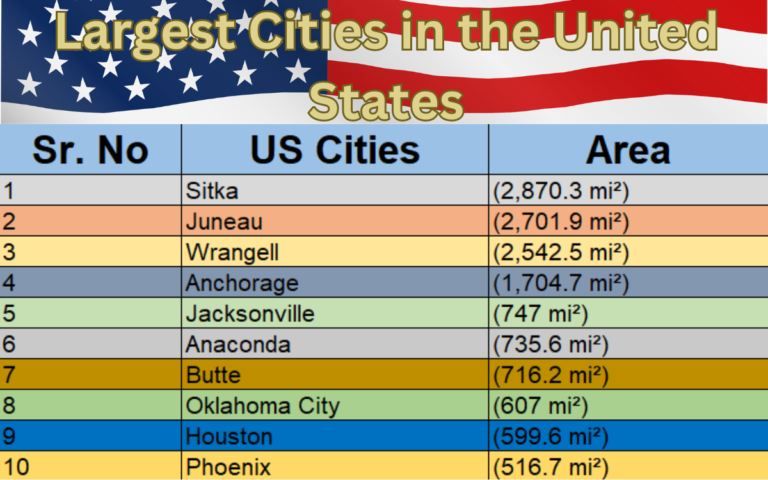Top 10 Things to Do in Paris City in 2024
Paris, often referred to as “The City of Light,” is one of the world’s most captivating and culturally rich destinations. Renowned for its stunning architecture, historic landmarks, world-class museums, and vibrant street life, Paris offers an array of activities and experiences that cater to every interest. Whether you’re a history buff, an art lover, a foodie, or simply looking to soak in the city’s unique atmosphere, Paris has something for everyone.
With its rich history, artistic heritage, and vibrant culture, there are many things to do in Paris city. Whether you’re exploring its famous landmarks, enjoying its culinary delights, or simply wandering its charming streets, Paris will enchant and inspire you.
List of Places to Visit in Paris
The following are the must-visit places in Paris:
- Eiffel Tower
- Musée du Louvre
- Notre-Dame Cathedral
- Champs-Élysées
- Arc de Triomphe
- Latin Quarter
- Seine River
- Musée d’Orsay
- Luxembourg Gardens
- Sacred Heart Basilica of Montmartre
1. Eiffel Tower
The Eiffel Tower, or Tour Eiffel, is one of the most iconic landmarks in the world. Located in Paris, France, it was constructed for the 1889 Exposition Universelle (World’s Fair) to commemorate the 100th anniversary of the French Revolution.
Standing at 324 meters (1,063 feet) tall, the Eiffel Tower was the world’s tallest man-made structure until the completion of the Chrysler Building in New York City in 1930. It is constructed of iron and weighs approximately 10,000 tons. The tower consists of three levels accessible to the public. The first and second levels feature restaurants and shops, while the third level, the top, offers stunning panoramic views of Paris.
The Eiffel Tower is painted every seven years to protect it from rust, requiring about 60 tons of paint each time. The colors have varied over the years, but it is currently painted in a shade known as “Eiffel Tower Brown.”
Visiting the Eiffel Tower is a must-do when in Paris. Tourists can reach the first and second levels either by elevator or by climbing the 704 steps. The top level is accessible only by elevator. The tower is especially enchanting at night when it is illuminated by 20,000 light bulbs, creating a sparkling effect every hour on the hour.
In addition to being a tourist attraction, the Eiffel Tower has played a role in history and science. During World War I, it was used as a giant radio antenna to intercept enemy communications. Today, it still serves as a broadcasting tower for radio and television signals.
You might also like: Top 10 Places to Visit in Spain
2. Musée du Louvre
The Musée du Louvre, commonly known as the Louvre Museum, is one of the world’s largest and most visited museums. Located in Paris, France, it is renowned for its extensive collection of art and historical artifacts. The museum is housed in the Louvre Palace, originally built as a fortress in the late 12th century by King Philip II. The building was transformed into a royal palace in the 16th century and later converted into a public museum during the French Revolution in 1793.
The Louvre’s collection spans over 9,000 years of history, with more than 35,000 works of art on display. Its most famous piece is undoubtedly Leonardo da Vinci’s “Mona Lisa,” a portrait that attracts millions of visitors annually. Other notable works include the “Venus de Milo,” the “Winged Victory of Samothrace,” and Eugène Delacroix’s “Liberty Leading the People.”
The museum is divided into eight departments: Near Eastern Antiquities, Egyptian Antiquities, Greek, Etruscan, and Roman Antiquities, Islamic Art, Sculptures, Decorative Arts, Paintings, and Prints and Drawings. Each department offers a rich array of artifacts, from ancient relics to Renaissance masterpieces.
Travelers visiting the Louvre should plan their trip, as the museum’s vast collection requires ample time to explore. The museum is open every day except Tuesdays, and it offers late-night hours on Wednesdays and Fridays. Tickets can be purchased online to avoid long lines.
Guided tours are available, providing insightful context and history about the exhibits. For those who prefer a self-guided experience, audio guides and maps are offered.
3. Notre-Dame Cathedral
Notre-Dame Cathedral, also known as Cathédrale Notre-Dame de Paris, is one of the most famous Gothic cathedrals in the world. Located on the Île de la Cité in the heart of Paris, France, it is renowned for its stunning architecture, historical significance, and cultural impact.
Notre Dame features classic Gothic elements such as flying buttresses, ribbed vaults, and spectacular stained glass windows. The cathedral’s twin towers, which stand at 69 meters (226 feet) tall, offer breathtaking views of Paris. Its iconic façade is adorned with detailed sculptures, including the famous gargoyles and the Gallery of Kings, a row of statues representing the 28 Kings of Judah.
The cathedral’s interior is equally impressive, with its vast nave, rose windows, and the historic Great Organ, one of the largest in France. The Crown of Thorns, a relic believed to have been worn by Jesus Christ, is housed within the cathedral and is displayed during special ceremonies.
Travelers visiting Notre Dame can explore the cathedral’s interior and climb the towers for a panoramic view of Paris. Entrance to the cathedral is free, but there is a fee to access the towers and the crypt. Guided tours are available, providing detailed insights into the cathedral’s history and architecture.
Located near several major attractions, including the Sainte-Chapelle and the Conciergerie, Notre Dame is easily accessible by public transportation, with nearby Metro and bus stops.
4. Champs-Élysées
The Champs-Élysées, officially known as Avenue des Champs-Élysées, is one of the most famous avenues in the world. Located in Paris, France, it stretches 1.9 kilometers (1.2 miles) from the Place de la Concorde to the Arc de Triomphe. The avenue is known for its theaters, cafés, and luxury shops, making it a bustling hub of activity and a major tourist attraction.
The Champs-Élysées was originally laid out in 1667 by André Le Nôtre as an extension of the Tuileries Garden. It was named after the Elysian Fields, the paradise for dead heroes in Greek mythology. Over the centuries, it has evolved into a symbol of Parisian elegance and prestige.
Lined with trees and beautifully landscaped gardens, the Champs-Élysées offers a picturesque setting for both strolls and high-end shopping. The lower part of the avenue, closest to the Place de la Concorde, is bordered by gardens, while the upper part, near the Arc de Triomphe, is known for its theaters, cinemas, and flagship stores of luxury brands such as Louis Vuitton, Chanel, and Dior.
For visitors, the Champs-Élysées offers a mix of cultural and commercial experiences. Key attractions along the avenue include the Grand Palais, a magnificent exhibition hall, and the Petit Palais, which houses the City of Paris Museum of Fine Arts. At the western end stands the imposing Arc de Triomphe, commissioned by Napoleon to honor his victories. Visitors can climb to the top of the Arc de Triomphe for a stunning view of Paris.
The avenue is easily accessible by public transportation, with several Metro stations along its length, including Champs-Élysées – Clemenceau, Franklin D. Roosevelt, and Charles de Gaulle – Étoile. Buses and taxis also serve the area, making it convenient to reach.
You might also like: Safest Cities In The World
5. Arc de Triomphe
The Arc de Triomphe, one of Paris’s most iconic monuments, stands at the western end of the Champs-Élysées in the center of Place Charles de Gaulle, formerly known as Place de l’Étoile. The monument was designed to honor the French army and celebrate their triumphs. It took 30 years to complete, with construction finishing in 1836 under the reign of King Louis-Philippe.
Standing 50 meters (164 feet) tall and 45 meters (148 feet) wide, the Arc de Triomphe features intricate sculptures and engravings. The names of 660 French generals and battles are inscribed on its inner and outer surfaces. Beneath its vault lies the Tomb of the Unknown Soldier, added in 1921 to honor the unidentified soldiers who died in World War I. An eternal flame, rekindled each evening, burns in memory of the fallen.
Visitors can climb 284 steps to reach the top of the Arc de Triomphe, where a panoramic terrace offers stunning views of Paris, including the Champs-Élysées, the Eiffel Tower, and the modern skyscrapers of La Défense. Inside the monument, a small museum details its history and significance.
The Arc de Triomphe is the focal point of major national celebrations in France. Every year on July 14th, Bastille Day, a military parade passes through the arch. The monument is also central to commemorations of Armistice Day on November 11th.
6. Latin Quarter
The Latin Quarter, or Quartier Latin, is one of the most vibrant and historic neighborhoods in Paris, France. Located on the left bank of the Seine River, it is known for its lively atmosphere, educational institutions, and rich cultural heritage. The area gets its name from the Latin language, which was widely spoken by the students of the medieval University of Paris, established in the 12th century.
The Latin Quarter is home to the Sorbonne, one of the oldest universities in Europe, which has been a center of learning and intellectual life for centuries. The neighborhood is also filled with numerous other educational institutions, including the Collège de France and the École Normale Supérieure.
Visitors to the Latin Quarter can explore a wealth of historic sites and landmarks. The Panthéon, originally built as a church and now a mausoleum contains the remains of many notable French figures, including Voltaire, Rousseau, Victor Hugo, and Marie Curie.
The Latin Quarter’s narrow, winding streets are lined with charming bookstores, cafes, and restaurants, creating a quintessential Parisian experience.
For those interested in performing arts, the Latin Quarter boasts several historic theaters and cinemas, such as the Théâtre de l’Odéon and the Cinéma du Panthéon, one of the oldest cinemas in Paris.
The Jardin des Plantes, a large botanical garden, is also located in the Latin Quarter. It features a zoo, greenhouses, and the National Museum of Natural History, offering a peaceful retreat amidst the urban environment.
Also explore: Beautiful Places to Visit in Switzerland
7. Seine River
The Seine River is a major waterway in France, flowing through the heart of Paris and playing a central role in the city’s history, culture, and daily life. Stretching about 777 kilometers (483 miles) from its source in the Burgundy region to its mouth at the English Channel in Le Havre, the Seine is one of Europe’s most famous rivers.
The Seine divides Paris into the Left Bank (Rive Gauche) and the Right Bank (Rive Droite), and its banks are home to many of the city’s most iconic landmarks.
The Seine has been a crucial part of Parisian life since ancient times. The city’s origins can be traced back to a settlement on the Île de la Cité, one of the river’s natural islands. Throughout history, the Seine has been used for trade, transportation, and as a source of inspiration for artists and writers.
One of the best ways to experience the Seine is by taking a river cruise. Numerous companies offer boat tours that provide a unique perspective of Paris’s landmarks, especially enchanting at night when the city’s monuments are illuminated. These cruises often include guided commentary, explaining the history and significance of the sites along the river.
The Seine’s embankments, known as the “Quais de Seine,” are UNESCO World Heritage Sites. These picturesque riverbanks are popular for leisurely walks, picnics, and cycling. In the summer, parts of the riverbank are transformed into “Paris Plages,” temporary urban beaches complete with sand, lounge chairs, and recreational activities.
Also explore: Best Places to Visit in France
8. Musée d’Orsay
The Musée d’Orsay is one of Paris’s most celebrated museums, renowned for its extensive collection of Impressionist and Post-Impressionist masterpieces. Housed in the former Gare d’Orsay, a Beaux-Arts railway station built between 1898 and 1900, the museum itself is a work of art, featuring a grand glass canopy and intricate architectural details. The museum is located on the left bank of the Seine River, opposite the Tuileries Garden.
The Musée d’Orsay officially opened in December 1986, and it houses French art dating from 1848 to 1914. Its collection includes paintings, sculptures, photography, decorative arts, and architectural drawings.
Key highlights of the Musée d’Orsay’s collection include:
- Claude Monet’s “Water Lilies” series captures the serene beauty of his garden in Giverny.
- Edgar Degas’s “The Ballet Class”, depicts the grace and discipline of ballerinas.
- Pierre-Auguste Renoir’s “Dance at Le Moulin de la Galette”, illustrates a lively scene of Parisians dancing and socializing.
- Vincent van Gogh’s “Starry Night Over the Rhône” and his self-portraits showcase his unique style and emotional depth.
- Édouard Manet’s “Olympia”, is a provocative piece that challenges traditional artistic norms.
Visitors to the Musée d’Orsay can enjoy its well-organized layout, which is arranged chronologically, allowing for a comprehensive understanding of the artistic movements of the period. The museum also hosts temporary exhibitions, lectures, and educational programs that provide deeper insights into its collections and themes.
9. Luxembourg Gardens
The Luxembourg Gardens, or Jardin du Luxembourg, is one of Paris’s most enchanting and beloved green spaces. Located in the 6th arrondissement, near the Latin Quarter, the gardens cover 23 hectares (56.8 acres) and are known for their beautifully manicured lawns, vibrant flower beds, and picturesque tree-lined promenades.
The gardens were originally commissioned by Marie de Medici, the widow of King Henry IV, in 1612. She wanted to create a park similar to the Boboli Gardens in her native Florence, Italy. At the heart of the Luxembourg Gardens is the Luxembourg Palace, which now houses the French Senate.
The gardens feature a harmonious blend of French and English landscaping styles, with formal terraces, geometric flower beds, and naturalistic areas. One of the central attractions is the large octagonal pond known as the Grand Bassin, where children can rent and sail miniature boats. Surrounding the pond are numerous statues, including a notable one of Marie de Medici herself.
The gardens also feature tennis courts, a marionette theater, playgrounds, and pony rides, making it a popular spot for families. Throughout the year, the Luxembourg Gardens host various cultural events, including concerts, art exhibitions, and open-air photography displays.
Visitors can enjoy leisurely walks along the tree-lined paths, relax on the iconic green chairs scattered throughout the gardens, or have a picnic on the expansive lawns. The gardens are also a favorite spot for Parisians to engage in sports, such as jogging and tai chi.
10. Sacred Heart Basilica of Montmartre
The Sacred Heart Basilica of Montmartre, known as Sacré-Cœur Basilica, is one of Paris’s most iconic landmarks. Situated at the highest point in the city on the Butte Montmartre, this majestic white-domed basilica offers stunning views over Paris.
The basilica’s Romano-Byzantine architecture is distinctive, with its white travertine stone that maintains its bright appearance even in the rain. The interior features a grand mosaic in the apse, “Christ in Majesty,” which is one of the largest mosaics in the world, covering 475 square meters.
The area surrounding the basilica, Montmartre, is famous for its artistic heritage. It was home to many renowned artists, including Pablo Picasso, Vincent van Gogh, and Henri de Toulouse-Lautrec. The neighborhood retains its bohemian charm with its narrow winding streets, charming cafes, and the lively Place du Tertre, where artists set up their easels to paint and sell their work.
Visiting Sacré-Cœur is a spiritual and cultural experience. The basilica is open every day from 6:00 AM to 10:30 PM, and entry is free, though there is a fee to access the dome and the crypt. The basilica is also known for its perpetual adoration of the Blessed Sacrament, ongoing since 1885.
Also see: 10 Most Visited Cities in the World
Conclusion
Paris is a city that captivates the hearts of visitors with its timeless charm and endless possibilities for exploration. Whether you’re visiting for the first time or returning to discover more of its hidden gems, things to do in Paris city leave a lasting impression. Its beauty, culture, and spirit make it a destination that you’ll want to revisit time and again.
FAQs
What Is Paris’ Most Famous Street?
Paris’s most famous street is undoubtedly the Champs-Élysées. Stretching from the Arc de Triomphe to Place de la Concorde, this grand avenue is renowned for its theaters, cafés, luxury shops, and historical monuments. It’s often associated with major celebrations and events, like the annual Bastille Day parade and the finish of the Tour de France. The Champs-Élysées embodies the elegance and vibrancy of Parisian life.
Is London or Paris Cheaper?
London is a more expensive city than Paris. Food, transportation, and activities are more expensive in the capital of the UK. However, hotels are expensive in both cities, especially during the peak season from May to September.
Is Paris Very Expensive?
Paris can be quite expensive, but the cost can vary depending on your choices and preferences.
- Accommodation: Hotels and vacation rentals in Paris can be pricey, especially in central or tourist-heavy areas. Budget options are available, but they might be farther from major attractions.
- Dining: Eating out in Paris can range from affordable street food and casual bistros to high-end Michelin-starred restaurants. Meals in tourist areas or upscale places tend to be more expensive.
- Transportation: The Paris Metro and buses are relatively affordable, with a carnet (a book of 10 tickets) providing a discount.
- Attractions: Many of Paris’s famous landmarks, such as the Louvre and the Eiffel Tower, have entrance fees.

I’m Sophia Jones, an adventurer at heart from New York City, USA. I live for travel and exploration, always eager to discover new places, meet fascinating people, and try out diverse cuisines. Over the past few years, I’ve traveled to numerous countries, immersing myself in different cultures and creating unforgettable memories.






